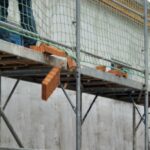Take 8 Steps to Prevent Objects from Falling from Heights

The focus of fall prevention is usually on preventing workers from falling from heights. But items such as tools, materials and other equipment can also fall from heights and endanger people below’including not only workers but also visitors and passersby. And even if the object that falls is relatively small, it can cause serious’sometimes fatal’injuries if it strikes someone.
For example, a 58-year-old man was killed in Jersey City, NJ by a one-pound tape measure after it fell about 400 feet. He was delivering wallboard to a large construction project. He’d just stepped out of his truck when he was hit by the tape measure, which had slipped off the belt of a construction worker at the top of the tower under construction.
The man, who wasn’t wearing a hardhat at the time, was struck in the head and knocked unconscious. He was taken to the hospital, where he died.
And in Calgary, a couple, their son and daughter were walking down the street when wind blew a bundle of steel off the roof of a construction project, striking them. The three-year-old daughter died instantly; the husband and son were injured. Two companies pleaded guilty to violating the Alberta Safety Codes Act by allowing an unsafe condition on the worksite and were each fined $15,000.
Bottom line: If you have workers working at heights, remember that the tools, materials and other items they use are also at risk of falling. So take these eight steps to prevent objects from falling and injuring people:
- Platforms should be constructed so that materials or objects can’t fall and cause injury to anyone or anything below. Close-boarded platforms are usually sufficient.
- For work over public areas, a double-boarded platform with a polythene sheet in between the boards prevents small items such as nails and bolts from falling.
- Toe boards also prevent items from being kicked off the edge of platforms.
- Providing a covered walkway is another way to protect people below.
- If you’re using a cradle, harness or mobile elevated working platform, mesh or netting can be used underneath the equipment to prevent anything falling and causing injury or damage.
- Covered chutes are an effective and quick method of removing debris from work areas and much safer than throwing items over the side of a platform into a skip below.
- Tools such as drills and trowels can be attached to safety lines. If they’re accidentally dropped, the line prevents them falling below the work area.
- Remember that wind can blow objects off platforms. If the weather is particularly severe, postpone work to avoid putting people at risk.